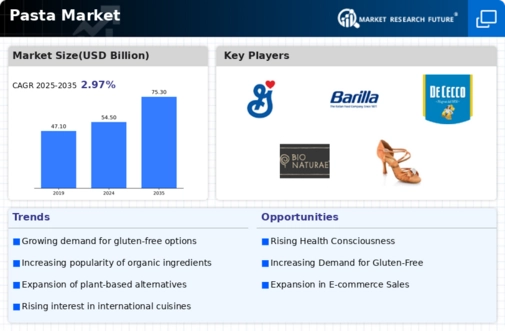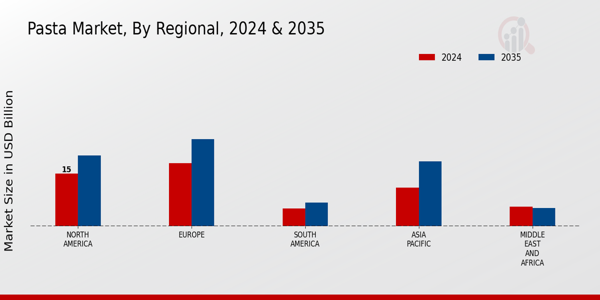Dried Pasta
Fresh Pasta
Frozen Pasta
Stuffed Pasta
Wheat
Rice
Legumes
Vegetable-Based
Supermarkets
Online Retail
Convenience Stores
Specialty Stores
Residential
Food Service
Catering
North America
Europe
South America
Asia Pacific
Middle East and Africa
North America Outlook (USD Billion, 2019-2035)
North America Pasta Market by Type
Dried Pasta
Fresh Pasta
Frozen Pasta
Stuffed Pasta
North America Pasta Market by Ingredients Type
Wheat
Rice
Legumes
Vegetable-Based
North America Pasta Market by Distribution Channel Type
Supermarkets
Online Retail
Convenience Stores
Specialty Stores
North America Pasta Market by End Use Type
Residential
Food Service
Catering
North America Pasta Market by Regional Type
US
Canada
US Outlook (USD Billion, 2019-2035)
US Pasta Market by Type
Dried Pasta
Fresh Pasta
Frozen Pasta
Stuffed Pasta
US Pasta Market by Ingredients Type
Wheat
Rice
Legumes
Vegetable-Based
US Pasta Market by Distribution Channel Type
Supermarkets
Online Retail
Convenience Stores
Specialty Stores
US Pasta Market by End Use Type
Residential
Food Service
Catering
CANADA Outlook (USD Billion, 2019-2035)
CANADA Pasta Market by Type
Dried Pasta
Fresh Pasta
Frozen Pasta
Stuffed Pasta
CANADA Pasta Market by Ingredients Type
Wheat
Rice
Legumes
Vegetable-Based
CANADA Pasta Market by Distribution Channel Type
Supermarkets
Online Retail
Convenience Stores
Specialty Stores
CANADA Pasta Market by End Use Type
Residential
Food Service
Catering
Europe Outlook (USD Billion, 2019-2035)
Europe Pasta Market by Type
Dried Pasta
Fresh Pasta
Frozen Pasta
Stuffed Pasta
Europe Pasta Market by Ingredients Type
Wheat
Rice
Legumes
Vegetable-Based
Europe Pasta Market by Distribution Channel Type
Supermarkets
Online Retail
Convenience Stores
Specialty Stores
Europe Pasta Market by End Use Type
Residential
Food Service
Catering
Europe Pasta Market by Regional Type
Germany
UK
France
Russia
Italy
Spain
Rest of Europe
GERMANY Outlook (USD Billion, 2019-2035)
GERMANY Pasta Market by Type
Dried Pasta
Fresh Pasta
Frozen Pasta
Stuffed Pasta
GERMANY Pasta Market by Ingredients Type
Wheat
Rice
Legumes
Vegetable-Based
GERMANY Pasta Market by Distribution Channel Type
Supermarkets
Online Retail
Convenience Stores
Specialty Stores
GERMANY Pasta Market by End Use Type
Residential
Food Service
Catering
UK Outlook (USD Billion, 2019-2035)
UK Pasta Market by Type
Dried Pasta
Fresh Pasta
Frozen Pasta
Stuffed Pasta
UK Pasta Market by Ingredients Type
Wheat
Rice
Legumes
Vegetable-Based
UK Pasta Market by Distribution Channel Type
Supermarkets
Online Retail
Convenience Stores
Specialty Stores
UK Pasta Market by End Use Type
Residential
Food Service
Catering
FRANCE Outlook (USD Billion, 2019-2035)
FRANCE Pasta Market by Type
Dried Pasta
Fresh Pasta
Frozen Pasta
Stuffed Pasta
FRANCE Pasta Market by Ingredients Type
Wheat
Rice
Legumes
Vegetable-Based
FRANCE Pasta Market by Distribution Channel Type
Supermarkets
Online Retail
Convenience Stores
Specialty Stores
FRANCE Pasta Market by End Use Type
Residential
Food Service
Catering
RUSSIA Outlook (USD Billion, 2019-2035)
RUSSIA Pasta Market by Type
Dried Pasta
Fresh Pasta
Frozen Pasta
Stuffed Pasta
RUSSIA Pasta Market by Ingredients Type
Wheat
Rice
Legumes
Vegetable-Based
RUSSIA Pasta Market by Distribution Channel Type
Supermarkets
Online Retail
Convenience Stores
Specialty Stores
RUSSIA Pasta Market by End Use Type
Residential
Food Service
Catering
ITALY Outlook (USD Billion, 2019-2035)
ITALY Pasta Market by Type
Dried Pasta
Fresh Pasta
Frozen Pasta
Stuffed Pasta
ITALY Pasta Market by Ingredients Type
Wheat
Rice
Legumes
Vegetable-Based
ITALY Pasta Market by Distribution Channel Type
Supermarkets
Online Retail
Convenience Stores
Specialty Stores
ITALY Pasta Market by End Use Type
Residential
Food Service
Catering
SPAIN Outlook (USD Billion, 2019-2035)
SPAIN Pasta Market by Type
Dried Pasta
Fresh Pasta
Frozen Pasta
Stuffed Pasta
SPAIN Pasta Market by Ingredients Type
Wheat
Rice
Legumes
Vegetable-Based
SPAIN Pasta Market by Distribution Channel Type
Supermarkets
Online Retail
Convenience Stores
Specialty Stores
SPAIN Pasta Market by End Use Type
Residential
Food Service
Catering
REST OF EUROPE Outlook (USD Billion, 2019-2035)
REST OF EUROPE Pasta Market by Type
Dried Pasta
Fresh Pasta
Frozen Pasta
Stuffed Pasta
REST OF EUROPE Pasta Market by Ingredients Type
Wheat
Rice
Legumes
Vegetable-Based
REST OF EUROPE Pasta Market by Distribution Channel Type
Supermarkets
Online Retail
Convenience Stores
Specialty Stores
REST OF EUROPE Pasta Market by End Use Type
Residential
Food Service
Catering
APAC Outlook (USD Billion, 2019-2035)
APAC Pasta Market by Type
Dried Pasta
Fresh Pasta
Frozen Pasta
Stuffed Pasta
APAC Pasta Market by Ingredients Type
Wheat
Rice
Legumes
Vegetable-Based
APAC Pasta Market by Distribution Channel Type
Supermarkets
Online Retail
Convenience Stores
Specialty Stores
APAC Pasta Market by End Use Type
Residential
Food Service
Catering
APAC Pasta Market by Regional Type
China
India
Japan
South Korea
Malaysia
Thailand
Indonesia
Rest of APAC
CHINA Outlook (USD Billion, 2019-2035)
CHINA Pasta Market by Type
Dried Pasta
Fresh Pasta
Frozen Pasta
Stuffed Pasta
CHINA Pasta Market by Ingredients Type
Wheat
Rice
Legumes
Vegetable-Based
CHINA Pasta Market by Distribution Channel Type
Supermarkets
Online Retail
Convenience Stores
Specialty Stores
CHINA Pasta Market by End Use Type
Residential
Food Service
Catering
INDIA Outlook (USD Billion, 2019-2035)
INDIA Pasta Market by Type
Dried Pasta
Fresh Pasta
Frozen Pasta
Stuffed Pasta
INDIA Pasta Market by Ingredients Type
Wheat
Rice
Legumes
Vegetable-Based
INDIA Pasta Market by Distribution Channel Type
Supermarkets
Online Retail
Convenience Stores
Specialty Stores
INDIA Pasta Market by End Use Type
Residential
Food Service
Catering
JAPAN Outlook (USD Billion, 2019-2035)
JAPAN Pasta Market by Type
Dried Pasta
Fresh Pasta
Frozen Pasta
Stuffed Pasta
JAPAN Pasta Market by Ingredients Type
Wheat
Rice
Legumes
Vegetable-Based
JAPAN Pasta Market by Distribution Channel Type
Supermarkets
Online Retail
Convenience Stores
Specialty Stores
JAPAN Pasta Market by End Use Type
Residential
Food Service
Catering
SOUTH KOREA Outlook (USD Billion, 2019-2035)
SOUTH KOREA Pasta Market by Type
Dried Pasta
Fresh Pasta
Frozen Pasta
Stuffed Pasta
SOUTH KOREA Pasta Market by Ingredients Type
Wheat
Rice
Legumes
Vegetable-Based
SOUTH KOREA Pasta Market by Distribution Channel Type
Supermarkets
Online Retail
Convenience Stores
Specialty Stores
SOUTH KOREA Pasta Market by End Use Type
Residential
Food Service
Catering
MALAYSIA Outlook (USD Billion, 2019-2035)
MALAYSIA Pasta Market by Type
Dried Pasta
Fresh Pasta
Frozen Pasta
Stuffed Pasta
MALAYSIA Pasta Market by Ingredients Type
Wheat
Rice
Legumes
Vegetable-Based
MALAYSIA Pasta Market by Distribution Channel Type
Supermarkets
Online Retail
Convenience Stores
Specialty Stores
MALAYSIA Pasta Market by End Use Type
Residential
Food Service
Catering
THAILAND Outlook (USD Billion, 2019-2035)
THAILAND Pasta Market by Type
Dried Pasta
Fresh Pasta
Frozen Pasta
Stuffed Pasta
THAILAND Pasta Market by Ingredients Type
Wheat
Rice
Legumes
Vegetable-Based
THAILAND Pasta Market by Distribution Channel Type
Supermarkets
Online Retail
Convenience Stores
Specialty Stores
THAILAND Pasta Market by End Use Type
Residential
Food Service
Catering
INDONESIA Outlook (USD Billion, 2019-2035)
INDONESIA Pasta Market by Type
Dried Pasta
Fresh Pasta
Frozen Pasta
Stuffed Pasta
INDONESIA Pasta Market by Ingredients Type
Wheat
Rice
Legumes
Vegetable-Based
INDONESIA Pasta Market by Distribution Channel Type
Supermarkets
Online Retail
Convenience Stores
Specialty Stores
INDONESIA Pasta Market by End Use Type
Residential
Food Service
Catering
REST OF APAC Outlook (USD Billion, 2019-2035)
REST OF APAC Pasta Market by Type
Dried Pasta
Fresh Pasta
Frozen Pasta
Stuffed Pasta
REST OF APAC Pasta Market by Ingredients Type
Wheat
Rice
Legumes
Vegetable-Based
REST OF APAC Pasta Market by Distribution Channel Type
Supermarkets
Online Retail
Convenience Stores
Specialty Stores
REST OF APAC Pasta Market by End Use Type
Residential
Food Service
Catering
South America Outlook (USD Billion, 2019-2035)
South America Pasta Market by Type
Dried Pasta
Fresh Pasta
Frozen Pasta
Stuffed Pasta
South America Pasta Market by Ingredients Type
Wheat
Rice
Legumes
Vegetable-Based
South America Pasta Market by Distribution Channel Type
Supermarkets
Online Retail
Convenience Stores
Specialty Stores
South America Pasta Market by End Use Type
Residential
Food Service
Catering
South America Pasta Market by Regional Type
Brazil
Mexico
Argentina
Rest of South America
BRAZIL Outlook (USD Billion, 2019-2035)
BRAZIL Pasta Market by Type
Dried Pasta
Fresh Pasta
Frozen Pasta
Stuffed Pasta
BRAZIL Pasta Market by Ingredients Type
Wheat
Rice
Legumes
Vegetable-Based
BRAZIL Pasta Market by Distribution Channel Type
Supermarkets
Online Retail
Convenience Stores
Specialty Stores
BRAZIL Pasta Market by End Use Type
Residential
Food Service
Catering
MEXICO Outlook (USD Billion, 2019-2035)
MEXICO Pasta Market by Type
Dried Pasta
Fresh Pasta
Frozen Pasta
Stuffed Pasta
MEXICO Pasta Market by Ingredients Type
Wheat
Rice
Legumes
Vegetable-Based
MEXICO Pasta Market by Distribution Channel Type
Supermarkets
Online Retail
Convenience Stores
Specialty Stores
MEXICO Pasta Market by End Use Type
Residential
Food Service
Catering
ARGENTINA Outlook (USD Billion, 2019-2035)
ARGENTINA Pasta Market by Type
Dried Pasta
Fresh Pasta
Frozen Pasta
Stuffed Pasta
ARGENTINA Pasta Market by Ingredients Type
Wheat
Rice
Legumes
Vegetable-Based
ARGENTINA Pasta Market by Distribution Channel Type
Supermarkets
Online Retail
Convenience Stores
Specialty Stores
ARGENTINA Pasta Market by End Use Type
Residential
Food Service
Catering
REST OF SOUTH AMERICA Outlook (USD Billion, 2019-2035)
REST OF SOUTH AMERICA Pasta Market by Type
Dried Pasta
Fresh Pasta
Frozen Pasta
Stuffed Pasta
REST OF SOUTH AMERICA Pasta Market by Ingredients Type
Wheat
Rice
Legumes
Vegetable-Based
REST OF SOUTH AMERICA Pasta Market by Distribution Channel Type
Supermarkets
Online Retail
Convenience Stores
Specialty Stores
REST OF SOUTH AMERICA Pasta Market by End Use Type
Residential
Food Service
Catering
MEA Outlook (USD Billion, 2019-2035)
MEA Pasta Market by Type
Dried Pasta
Fresh Pasta
Frozen Pasta
Stuffed Pasta
MEA Pasta Market by Ingredients Type
Wheat
Rice
Legumes
Vegetable-Based
MEA Pasta Market by Distribution Channel Type
Supermarkets
Online Retail
Convenience Stores
Specialty Stores
MEA Pasta Market by End Use Type
Residential
Food Service
Catering
MEA Pasta Market by Regional Type
GCC Countries
South Africa
Rest of MEA
GCC COUNTRIES Outlook (USD Billion, 2019-2035)
GCC COUNTRIES Pasta Market by Type
Dried Pasta
Fresh Pasta
Frozen Pasta
Stuffed Pasta
GCC COUNTRIES Pasta Market by Ingredients Type
Wheat
Rice
Legumes
Vegetable-Based
GCC COUNTRIES Pasta Market by Distribution Channel Type
Supermarkets
Online Retail
Convenience Stores
Specialty Stores
GCC COUNTRIES Pasta Market by End Use Type
Residential
Food Service
Catering
SOUTH AFRICA Outlook (USD Billion, 2019-2035)
SOUTH AFRICA Pasta Market by Type
Dried Pasta
Fresh Pasta
Frozen Pasta
Stuffed Pasta
SOUTH AFRICA Pasta Market by Ingredients Type
Wheat
Rice
Legumes
Vegetable-Based
SOUTH AFRICA Pasta Market by Distribution Channel Type
Supermarkets
Online Retail
Convenience Stores
Specialty Stores
SOUTH AFRICA Pasta Market by End Use Type
Residential
Food Service
Catering
REST OF MEA Outlook (USD Billion, 2019-2035)
REST OF MEA Pasta Market by Type
Dried Pasta
Fresh Pasta
Frozen Pasta
Stuffed Pasta
REST OF MEA Pasta Market by Ingredients Type
Wheat
Rice
Legumes
Vegetable-Based
REST OF MEA Pasta Market by Distribution Channel Type
Supermarkets
Online Retail
Convenience Stores
Specialty Stores
REST OF MEA Pasta Market by End Use Type
Residential
Food Service
Catering









Leave a Comment